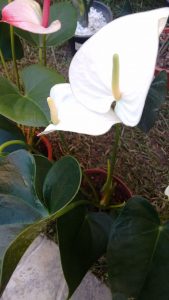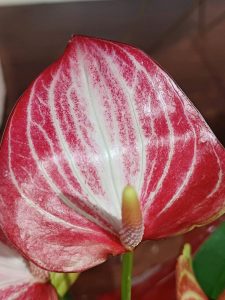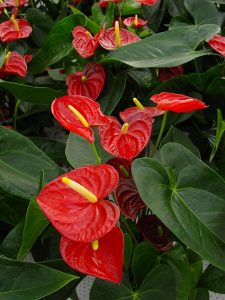The main characteristic of the anthurium is its shiny, colorful flower clusters. Under ideal conditions, these beautiful plants can bloom repeatedly throughout the year. So, what should you do if your plant isn’t blooming? Is there any way to get your anthurium to bloom again?
Anthuriums are sensitive to environmental conditions, so you’ll want to make sure your anthurium has the proper light, temperature, and humidity to encourage flowering. It’s also worth checking whether your plant is growing in the wrong soil type and whether it’s being overwatered – two common mistakes epiphytes make.
If adjusting these factors isn’t enough to restore your anthurium’s vibrant blooms, you can also enhance its blooms through careful application of fertilizer. If the plant has been in the same pot for a while, you may need to flush the soil or use a larger container. We’ll discuss all of these options in more detail below.
How do anthurium flowers bloom?


The anthurium family is actually quite large and includes many different plants. What these plants have in common is producing dense blooms surrounded by colorful foliage.
What most people think of as an anthurium “flower” is actually a special type of leaf called a spathe. The flowers themselves are small and grow densely on an inflorescence, with a slender “tail” visible from the center. The structure containing all these elements is called an inflorescence.
It can be a little difficult to type this over and over again, so sometimes we just refer to them as “blooms”.
Inflorescences usually grow above the actual leaves of the plant (the green, leafy part of the plant). The most common variety of anthurium in the United States has large, heart-shaped leaves that are attractive in their own right.
These popular varieties bloom in red, pink, white, or a combination of these colors—one of the reasons they’re called “flamingo flowers.” When healthy, the leaves should be bright green and the spathe should have a waxy, glossy appearance.
Because they are tropical plants, they have no inherent seasonal cycle. In contrast, anthuriums typically bloom in a three-month flowering, three-month dormant pattern. If they’re happy, they can keep it that way year-round.
1: Avoid Overwatering
We’re starting with this advice both because proper watering is trickier than many houseplant owners realize, and because messing this up can have such disastrous consequences.
Not only can overwatering your Anthurium suppress its flowering, if it goes on long enough, it can cause your plant to develop root rot. This condition is the bane of indoor plants, and in some cases, it can damage your Anthurium beyond repair before you even realize there’s a problem. The most common cause? A fixed watering schedule.
While it might seem logical to water your Anthurium regularly, you can’t assume that the plant will absorb exactly the same amount of moisture every time. If the roots get more water than they can handle, the excess will remain in the soil. And soggy soil is the perfect breeding ground for disease.
2: Use a well-drained pot

This is the other half of preventing root rot. Even if you don’t water your plants too much, the same problem can occur if too much liquid accumulates in the pot.
Remember when we said about watering until the water comes out of the drainage hole? Yes, your anthurium pot should always have drainage holes! This will allow excess liquid to drain away from the plant’s roots.
Another great way to improve drainage is to add a layer of pebbles to the bottom of your underground container. But remember, the drainage holes are still most important. A layer of pebbles can be used with drainage holes but should not be used as a substitute for non-porous planters.
3 Use loose potting mix
Speaking of soil, another cause of insufficient drainage is planting your anthurium in soil that is too dense for its roots.
These plants prefer coarse potting soil. It’s best to start with an orchid mixture and refine it with some additives to make it looser.
4 Provide ample indirect light
Besides watering issues, the most common reason why anthuriums won’t bloom is a lack of light. They can even survive in fairly dark conditions, but if the light is bad, they have no incentive to show off their wares.
However, this doesn’t mean you should place them directly in front of a south-facing window. Anthuriums are jungle plants accustomed to diffuse sunlight filtering through the rainforest canopy. If they receive too much direct light, their leaves and spathes may develop a pale, bleached appearance.
6 keep moist

Once again you are dealing with rainforest plants – plants that thrive in moist environments. If the air is too dry, your anthurium is less likely to feel confident blooming.
If your bathroom has a lot of indirect light, this may be an ideal location for an anthurium. If not, try keeping a spray bottle next to it and spraying it every time you pass by. You can also place a small humidifier nearby.
7 Keep it comfortable
Temperature fluctuations can also stress anthuriums and prevent them from blooming. Place it somewhere where ventilation is infrequent and where the heat is fairly constant.
Your target temperature range should be 70 to 85 degrees Fahrenheit. For those who prefer metric units, that’s about 21-29 degrees Celsius.
7: Prune wilted flowers
Decapitating is an easy way to keep anthuriums in bloom. Each inflorescence of the plant draws on some of the stored energy to sustain itself, even those that have faded. By pruning these back, you will help your anthurium focus on producing new, healthy flowers.
8: Fertilize often, but not too much

If you’ve followed the tips above and your anthurium still isn’t blooming, you can try increasing its nutrients.
Wild anthuriums absorb steady, weak nutrients from rainwater and the decaying remains of other plants. Fortunately, you can simulate this without going into the jungle by regularly applying diluted fertilizer.
9: Wash the floor
If you follow tip #8, be aware that salt compounds in fertilizers can build up in the soil over time. If these concentrations are high enough, they can cause real stress on your anthurium – another factor that prevents the plant from producing beautiful buds.
10: Replant anthurium
Another way to restore your plant’s flowering potential is to repot it. Over time, container-grown anthuriums tend to stick to their roots. The usual recommendation is to transplant to a slightly larger container every two years. A good sign that it’s time to transplant your anthurium is when it begins to sprout from the soil surface.










